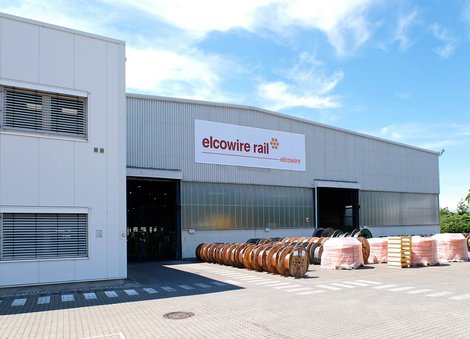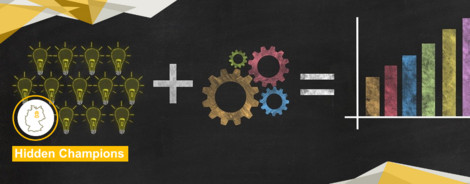Wire-to-Wire Success: Paving the Way for Environmentally Friendly Transport

As a world market leader for catenary systems made of copper and copper alloys, Elcowire Rail in Hettstedt is one of Saxony-Anhalt’s Hidden Champions
If you take the high-speed train through the new Ceneri Base Tunnel in the Swiss Canton of Ticino or travel on the high-speed rail route between Madrid and Barcelona, where trains reach 350 km/h, Elcowire Rail’s catenary systems help provide the power to get from A to B.
The firm – based in Hettstedt in the Mansfelder Land region of Saxony-Anhalt – produces contact wires, dropper wires and messenger wires made of pure copper and from different copper alloys for intercity and urban railways as well as for other overhead line applications. It has belonged to the Swedish Elcowire Group since 2019 and is active on the global market, making it one of Saxony-Anhalt’s Hidden Champions. This title is used in business to describe specialist companies that, despite being world market leaders in their field, are relatively unknown among the general public.
“We deliver to around 40 international markets each year,” says Dr. Jan Siebert, Managing Director of Elcowire Rail GmbH. The company generates 30% to 35% of its turnover in Germany, Austria and Switzerland (known collectively as the “DACH region”). This is then followed by other European nations such as France, Spain, the Scandinavian countries, the United Kingdom and Ireland.
But Elcowire Rail has also supplied its high-quality products to North and South America, Southeast Asia and Australia. It is a market leader for catenary systems: each year, between 8,000 and 10,000 tonnes of different types of copper and special copper alloy wires and cables leave its factory in the south of Saxony-Anhalt.
Long-standing experience in copper processing
Elcowire Rail’s production site is situated in a region of Saxony-Anhalt that has a history of ore mining and copper processing dating back more than 800 years. Elcowire Rail’s own history goes back 30 years. Founded as a joint venture between Hettstedt rolling mill and the company Felten & Guilleaume based in Cologne, it was first taken over by a Danish company in 2009 and then by the Swedish Elcowire Group ten years later. “This has been good for our core business, good for investment and sales and has secured good jobs for the people of Mansfelder Land,” says Dr. Siebert.
Specialists in copper alloy catenary systems
Elcowire Rail GmbH has a wealth of expertise in copper processing for messenger, dropper and contact wires that are subject to different mechanical and thermal stresses and voltages and currents. The company’s specialist knowledge covers long-distance routes supplied with direct or alternating current as well as urban railways and open-pit mines, providing zero-emission transport for loads of up to 600 tonnes.
“Our research and development work has led to the creation of contact wires that have a lifespan up to three times higher than pure copper contact wires and that also have very low energy loss during power transmission,” says Dr. Siebert. This helps to sustainably protect resources, reduce repair costs and meet tough climate targets. Elcowire Rail manufactures overhead lines from the most reliable materials to enable passenger and freight trains to reach high speeds on long-distance routes. “The European rail speed record is held by a French TGV test train, which reached 574.8 km/h on an electrified route with a catenary system made in Saxony-Anhalt,” he says proudly.
In 2020, the catenary system specialist supplied 500 tonnes of overhead lines to Malaysia, where they were used in the construction of a 230-km-long electrified railway line from Gemas to Johor Bahru just north of the border with Singapore. The hardwired pioneers from Saxony-Anhalt are also involved in the Raide-Jokeri project, which will see the construction of a 25-km-long light rail line around Finland’s capital Helsinki.
Electromobility coming to our highways soon
Electromobility will play an important role in the future in meeting the climate targets set by the UN’s Paris Agreement. Dr. Siebert explains that, in addition to battery-powered cars, electromobility also includes catenary systems for trucks. Hybrid trucks powered by both overhead lines and combustion engines are already being tested on “e-highways” in California, Sweden and on three test routes in Germany. Supplying electricity from renewable sources (e.g., wind power) could help to greatly reduce emissions of the greenhouse gas CO2. Managing Director Siebert is optimistic about the future of the production site in Saxony-Anhalt. Elcowire Rail is investing in a new production machine for the Hettstedt site, supported by funds from the Investment Bank of Saxony-Anhalt.
Author: Uwe Seidenfaden/IMG Saxony-Anhalt

In many industries, they belong to the innovation drivers in Europe and they are regarded as the originators of Germany's export success. As small to medium-sized companies, they often bring their niche applications to the world market faster than large companies, mostly resulting from in-house research. This self-developed success is one of their secrets.
